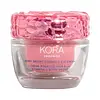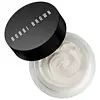What's inside
What's inside
 Key Ingredients
Key Ingredients

 Benefits
Benefits

 Concerns
Concerns

 Ingredients Side-by-side
Ingredients Side-by-side

Aloe Barbadensis Leaf Juice
Skin ConditioningRosa Canina Seed Oil
EmollientGlycerin
HumectantBalanites Roxburghii Seed Oil
Skin ConditioningCetearyl Alcohol
EmollientWater
Skin ConditioningCoconut Alkanes
EmollientLactobacillus Ferment
Skin ConditioningOleic/Linoleic/Linolenic Polyglycerides
EmollientCetearyl Olivate
Sorbitan Olivate
EmulsifyingPropanediol
SolventAscorbyl Glucoside
AntioxidantPersea Gratissima Oil
Skin ConditioningHelianthus Annuus Seed Oil
EmollientLactobacillus
Skin ConditioningButyrospermum Parkii Butter
Skin ConditioningCoco-Caprylate/Caprate
EmollientPotassium Sorbate
PreservativeEclipta Prostrata Extract
Skin ConditioningCocos Nucifera Fruit Extract
EmollientChenopodium Quinoa Seed Extract
Skin ConditioningPanax Ginseng Root Extract
EmollientSclerotium Gum
Emulsion StabilisingRubus Chamaemorus Fruit Extract
AntioxidantMorinda Citrifolia Fruit Extract
Skin ConditioningSodium Phytate
Anigozanthos Flavidus Extract
Skin ConditioningMelia Azadirachta Leaf Extract
Skin ConditioningTerminalia Ferdinandiana Fruit Extract
AntioxidantSodium Benzoate
MaskingPotassium Hydroxide
BufferingHippophae Rhamnoides Fruit Oil
Skin ProtectingTocopherol
AntioxidantMoringa Oleifera Seed Oil
EmollientAlcohol
AntimicrobialAloe Barbadensis Leaf Juice, Rosa Canina Seed Oil, Glycerin, Balanites Roxburghii Seed Oil, Cetearyl Alcohol, Water, Coconut Alkanes, Lactobacillus Ferment, Oleic/Linoleic/Linolenic Polyglycerides, Cetearyl Olivate, Sorbitan Olivate, Propanediol, Ascorbyl Glucoside, Persea Gratissima Oil, Helianthus Annuus Seed Oil, Lactobacillus, Butyrospermum Parkii Butter, Coco-Caprylate/Caprate, Potassium Sorbate, Eclipta Prostrata Extract, Cocos Nucifera Fruit Extract, Chenopodium Quinoa Seed Extract, Panax Ginseng Root Extract, Sclerotium Gum, Rubus Chamaemorus Fruit Extract, Morinda Citrifolia Fruit Extract, Sodium Phytate, Anigozanthos Flavidus Extract, Melia Azadirachta Leaf Extract, Terminalia Ferdinandiana Fruit Extract, Sodium Benzoate, Potassium Hydroxide, Hippophae Rhamnoides Fruit Oil, Tocopherol, Moringa Oleifera Seed Oil, Alcohol
Water
Skin ConditioningPetrolatum
EmollientDimethicone
EmollientButyrospermum Parkii Butter
Skin ConditioningGlycerin
HumectantButylene Glycol
HumectantCeresin
Emulsion StabilisingPhenyl Trimethicone
Skin ConditioningLauryl PEG-9 Polydimethylsiloxyethyl Dimethicone
Skin ConditioningLanolin Alcohol
EmollientSorbitol
HumectantSodium Hyaluronate
HumectantScutellaria Baicalensis Root Extract
AstringentMorus Bombycis Root Extract
Skin ConditioningAscophyllum Nodosum Extract
Skin ConditioningAsparagopsis Armata Extract
Skin ProtectingCamellia Sinensis Leaf Extract
AntimicrobialOlea Europaea Fruit Extract
BleachingSalvia Sclarea Extract
AntiseborrhoeicPyrus Malus Fruit Extract
Skin ConditioningAcetyl Hexapeptide-8
HumectantLimnanthes Alba Seed Oil
Skin ConditioningOenothera Biennis Oil
EmollientTocopheryl Acetate
AntioxidantAcetyl Glucosamine
Skin ConditioningLinoleic Acid
CleansingCaffeine
Skin ConditioningMicrococcus Lysate
Skin ConditioningDi-C12-15 Alkyl Fumarate
EmollientVitis Vinifera Seed Oil
EmollientTriticum Vulgare Bran Extract
Skin ConditioningTrehalose
HumectantCholesterol
EmollientPinanediol
Skin ConditioningCamphanediol
Skin ConditioningSucrose
HumectantStearic Acid
CleansingPalmitic Acid
EmollientLecithin
EmollientPotassium Hydroxide
BufferingSilica
AbrasivePentylene Glycol
Skin ConditioningPEG-30 Dipolyhydroxystearate
EmulsifyingSodium Chloride
MaskingHydroxystearic Acid
CleansingPEG-8 Distearate
EmulsifyingBehenyl Alcohol
EmollientParfum
MaskingBenzyl Salicylate
PerfumingSodium Sulfite
PreservativeSodium Metabisulfite
AntioxidantDisodium EDTA
Tetrasodium EDTA
Chlorphenesin
AntimicrobialPotassium Sorbate
PreservativePhenoxyethanol
PreservativeWater, Petrolatum, Dimethicone, Butyrospermum Parkii Butter, Glycerin, Butylene Glycol, Ceresin, Phenyl Trimethicone, Lauryl PEG-9 Polydimethylsiloxyethyl Dimethicone, Lanolin Alcohol, Sorbitol, Sodium Hyaluronate, Scutellaria Baicalensis Root Extract, Morus Bombycis Root Extract, Ascophyllum Nodosum Extract, Asparagopsis Armata Extract, Camellia Sinensis Leaf Extract, Olea Europaea Fruit Extract, Salvia Sclarea Extract, Pyrus Malus Fruit Extract, Acetyl Hexapeptide-8, Limnanthes Alba Seed Oil, Oenothera Biennis Oil, Tocopheryl Acetate, Acetyl Glucosamine, Linoleic Acid, Caffeine, Micrococcus Lysate, Di-C12-15 Alkyl Fumarate, Vitis Vinifera Seed Oil, Triticum Vulgare Bran Extract, Trehalose, Cholesterol, Pinanediol, Camphanediol, Sucrose, Stearic Acid, Palmitic Acid, Lecithin, Potassium Hydroxide, Silica, Pentylene Glycol, PEG-30 Dipolyhydroxystearate, Sodium Chloride, Hydroxystearic Acid, PEG-8 Distearate, Behenyl Alcohol, Parfum, Benzyl Salicylate, Sodium Sulfite, Sodium Metabisulfite, Disodium EDTA, Tetrasodium EDTA, Chlorphenesin, Potassium Sorbate, Phenoxyethanol
Ingredients Explained
These ingredients are found in both products.
Ingredients higher up in an ingredient list are typically present in a larger amount.
This ingredient is also known as shea butter. It is an effective skin hydrator and emollient.
Emollients help soothe and soften your skin. It does this by creating a protective film on your skin. This barrier helps trap moisture and keeps your skin hydrated. Emollients may be effective at treating dry or itchy skin.
Shea butter is rich in antioxidants. Antioxidants help fight free-radicals, or molecules that may harm the body. It is also full of fatty acids including stearic acid and linoleic acid. These acids help replenish the skin and keep skin moisturized.
While Shea Butter has an SPF rating of about 3-4, it is not a sunscreen replacement.
Shea butter may not be fungal acne safe. We recommend speaking with a professional if you have any concerns.
Learn more about Butyrospermum Parkii ButterGlycerin is already naturally found in your skin. It helps moisturize and protect your skin.
A study from 2016 found glycerin to be more effective as a humectant than AHAs and hyaluronic acid.
As a humectant, it helps the skin stay hydrated by pulling moisture to your skin. The low molecular weight of glycerin allows it to pull moisture into the deeper layers of your skin.
Hydrated skin improves your skin barrier; Your skin barrier helps protect against irritants and bacteria.
Glycerin has also been found to have antimicrobial and antiviral properties. Due to these properties, glycerin is often used in wound and burn treatments.
In cosmetics, glycerin is usually derived from plants such as soybean or palm. However, it can also be sourced from animals, such as tallow or animal fat.
This ingredient is organic, colorless, odorless, and non-toxic.
Glycerin is the name for this ingredient in American English. British English uses Glycerol/Glycerine.
Learn more about GlycerinPotassium hydroxide is commonly known as caustic potash. It is used to fix the pH of a product or as a cleaning agent in soap. In cleansers, it is used for the saponification of oils.
Sapnification is the process of creating fatty acid metal salts from triglycerides and a strong base. During this process, Potassium Hydroxide is used up and is not present in the final product.
Using high concentrations of Potassium Hydroxide have shown to irritate the skin.
Learn more about Potassium HydroxidePotassium Sorbate is a preservative used to prevent yeast and mold in products. It is commonly found in both cosmetic and food products.
This ingredient comes from potassium salt derived from sorbic acid. Sorbic acid is a natural antibiotic and effective against fungus.
Both potassium sorbate and sorbic acid can be found in baked goods, cheeses, dried meats, dried fruit, ice cream, pickles, wine, yogurt, and more.
You'll often find this ingredient used with other preservatives.
Learn more about Potassium SorbateWater. It's the most common cosmetic ingredient of all. You'll usually see it at the top of ingredient lists, meaning that it makes up the largest part of the product.
So why is it so popular? Water most often acts as a solvent - this means that it helps dissolve other ingredients into the formulation.
You'll also recognize water as that liquid we all need to stay alive. If you see this, drink a glass of water. Stay hydrated!
Learn more about Water